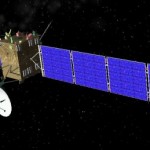 ESA The Rosetta spacecraft is due to wake up on the morning of January 20 after an 18-month hibernation in deep space. For the past ten years, the three-ton spacecraft has been on a one-way trip to a 4 km-wide comet. When it arrives, it will set about performing a maneuver that has never been done before: landing on a comet’s surface. The spacecraft has already achieved some success on its long journey through the solar system. It has passed by two asteroids—Steins in 2008 and Lutetia in 2010—and it tried out some of its instruments on them. Because Rosetta’s journey is so protracted, however, preserving energy has been of the utmost importance, which is why it was put into hibernation in June 2011. The journey has taken so long because the spacecraft needed to be “gravity-assisted” by many planets in order to reach the necessary velocity to match the comet’s orbit. Rosetta’s path through the inner Solar System. When it wakes up, Rosetta is expected to take a few hours to establish contact with Earth, 673 million km (396 million mi) away. The scientists involved will wait with bated breath. Dan Andrews, part of a team at the Open University who built one of Rosetta’s on-board instruments, said, “If there isn’t sufficient power, Rosetta will go back to sleep and try again later. The wake-up process is driven by software commands already on the spacecraft. It will wake itself up autonomously and spend some time warming up and orienting its antenna toward Earth to ‘phone home.’” Read 10 remaining paragraphs | Comments
ESA The Rosetta spacecraft is due to wake up on the morning of January 20 after an 18-month hibernation in deep space. For the past ten years, the three-ton spacecraft has been on a one-way trip to a 4 km-wide comet. When it arrives, it will set about performing a maneuver that has never been done before: landing on a comet’s surface. The spacecraft has already achieved some success on its long journey through the solar system. It has passed by two asteroids—Steins in 2008 and Lutetia in 2010—and it tried out some of its instruments on them. Because Rosetta’s journey is so protracted, however, preserving energy has been of the utmost importance, which is why it was put into hibernation in June 2011. The journey has taken so long because the spacecraft needed to be “gravity-assisted” by many planets in order to reach the necessary velocity to match the comet’s orbit. Rosetta’s path through the inner Solar System. When it wakes up, Rosetta is expected to take a few hours to establish contact with Earth, 673 million km (396 million mi) away. The scientists involved will wait with bated breath. Dan Andrews, part of a team at the Open University who built one of Rosetta’s on-board instruments, said, “If there isn’t sufficient power, Rosetta will go back to sleep and try again later. The wake-up process is driven by software commands already on the spacecraft. It will wake itself up autonomously and spend some time warming up and orienting its antenna toward Earth to ‘phone home.’” Read 10 remaining paragraphs | Comments
View original post here:
Sleeping spacecraft Rosetta nearly ready to wake up for comet landing






